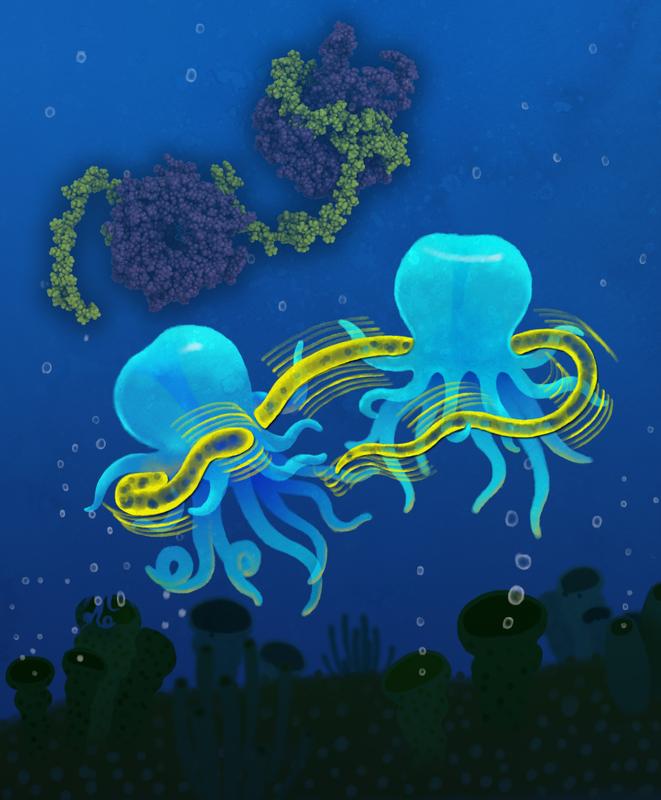Channels for the Supply of Energy

This image shows a graphical depiction how mitochondrial TIM transfer-chaperones use multiple clamp-like binding sites to transport membrane protein substrates in elongated, nascent chain like conformation through the mitochondrial intermembrane space. The image depicts this principle by showing two ‘dodecapuses’ holding a sea snake with multiple of their tentacles. Image: Yong Wang (Lindorff-Larsen lab) and Wei Chen
Working in cooperation with international colleagues, researchers from the University of Freiburg have described how water-insoluble membrane proteins are transported through the aqueous space between the mitochondrial membranes with the aid of chaperone proteins.
The membrane proteins enable the cellular powerhouses to import and export small biomolecules. Thus the team led by Prof. Dr. Nils Wiedemann from Freiburg and Dr. Paul Schanda from Grenoble (France) together with researchers from the University of Copenhagen (Denmark) and the University of Tübingen has answered a fundamental question about the formation of mitochondria.
The European Research Council (ERC) funded the research with both a Consolidator Grant and a Starting Grant. The scientists have published their results in the science journal Cell.
In the same way that the human body consists of various organs, eukaryotic cells contain small organelles such as the mitochondria, which synthesize the energy molecule adenosine triphosphate (ATP). The total amount of ATP that the mitochondrial membranes transport to supply the cells each day is roughly as much as the individual's body weight.
This process depends on special channel and transporter protein molecules that are present in the inner membrane and outer membrane of mitochondria. These channels and transporters are produced outside the mitochondria and are transported across the outer membrane.
Although these protein molecules are not soluble in water, they have to be transported through the aqueous intermembrane space, so that they can be integrated into the outer or inner mitochondrial membrane.
To achieve this, the intermembrane space contains special TIM chaperone proteins, which bind the channel and transporter proteins to facilitate their transport through the intermembrane space.
To identify the molecular mechanism of this process Dr. Katharina Weinhäupl performed structural work and Caroline Lindau performed functional mitochondrial studies which complemented each other.
The results show that the ring-shaped TIM chaperones have six water-repellent brackets to which the channels and transporters are loosely attached to prevent their aggregation. This is important because many diseases such as Alzheimer's or Parkinson's are associated with the formation of aggregates of protein molecules. Likewise, a malfunction of the TIM chaperones can cause Mohr-Tranebjærg syndrome with neurological deafness and movement disorders.
Nils Wiedemann is a group leader at the Institute of Biochemistry and Molecular Biology and a member of the Cluster of Excellence BIOSS Centre for Biological Signalling Studies as well as the Spemann Graduate School of Biology and Medicine (SGBM) at the University of Freiburg.
Original publication:
Katharina Weinhäupl, Caroline Lindau, Audrey Hessel, Yong Wang, Conny Schütze, Tobias Jores, Laura Melchionda, Birgit Schönfisch, Hubert Kalbacher, Beate Bersch, Doron Rapaport, Martha Brennich, Kresten Lindorff-Larsen, Nils Wiedemann, Paul Schanda: Structural Basis of Membrane Protein Chaperoning Through the Mitochondrial Intermembrane Space. In: Cell 175, 1365-1379. https://doi.org/10.1016/j.cell.2018.10.039
Caption:
This image shows a graphical depiction how mitochondrial TIM transfer-chaperones use multiple clamp-like binding sites to transport membrane protein substrates in elongated, nascent chain like conformation through the mitochondrial intermembrane space. The image depicts this principle by showing two ‘dodecapuses’ holding a sea snake with multiple of their tentacles.
Image: Yong Wang (Lindorff-Larsen lab) and Wei Chen
Contact:
Prof. Dr. Nils Wiedemann
Institute of Biochemistry and Molecular Biology
University of Freiburg
Tel.: +49 761 203-5280
nils.wiedemann@biochemie.uni-freiburg.de
https://www.pr.uni-freiburg.de/pm-en/press-releases-2018/channels-for-the-supply…
Media Contact
All latest news from the category: Life Sciences and Chemistry
Articles and reports from the Life Sciences and chemistry area deal with applied and basic research into modern biology, chemistry and human medicine.
Valuable information can be found on a range of life sciences fields including bacteriology, biochemistry, bionics, bioinformatics, biophysics, biotechnology, genetics, geobotany, human biology, marine biology, microbiology, molecular biology, cellular biology, zoology, bioinorganic chemistry, microchemistry and environmental chemistry.
Newest articles

NASA: Mystery of life’s handedness deepens
The mystery of why life uses molecules with specific orientations has deepened with a NASA-funded discovery that RNA — a key molecule thought to have potentially held the instructions for…

What are the effects of historic lithium mining on water quality?
Study reveals low levels of common contaminants but high levels of other elements in waters associated with an abandoned lithium mine. Lithium ore and mining waste from a historic lithium…

Quantum-inspired design boosts efficiency of heat-to-electricity conversion
Rice engineers take unconventional route to improving thermophotovoltaic systems. Researchers at Rice University have found a new way to improve a key element of thermophotovoltaic (TPV) systems, which convert heat…



